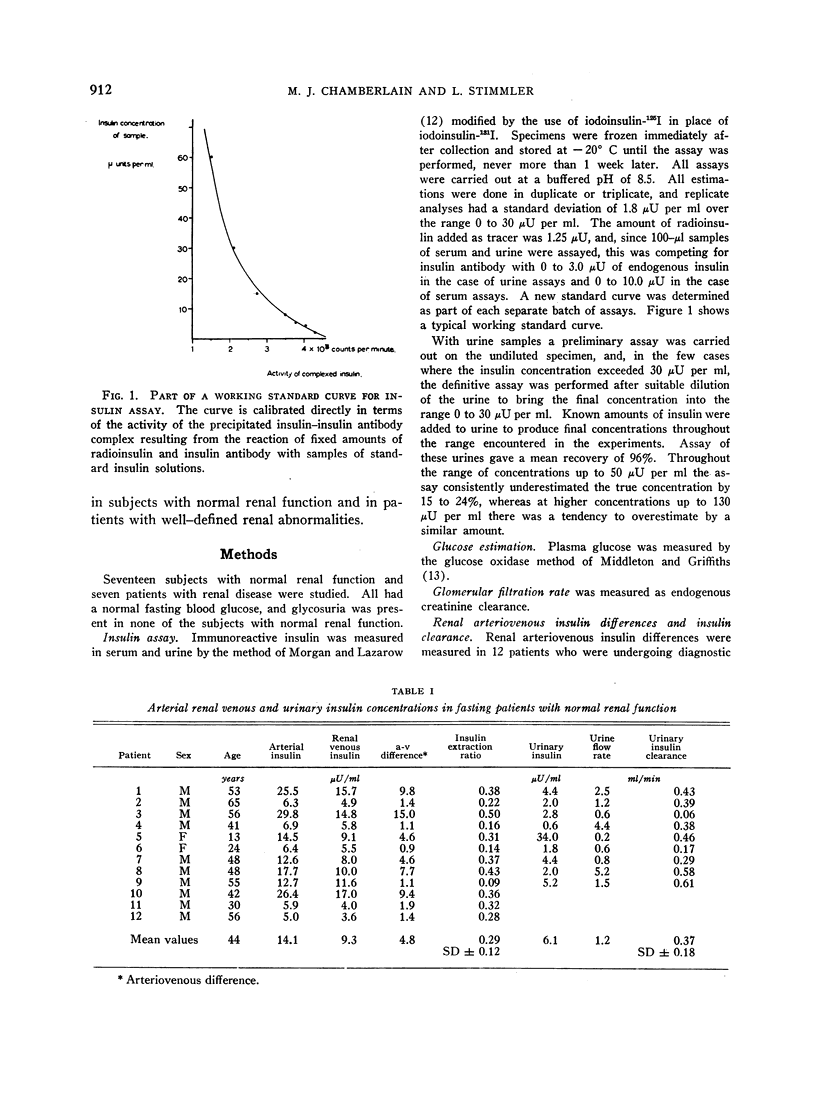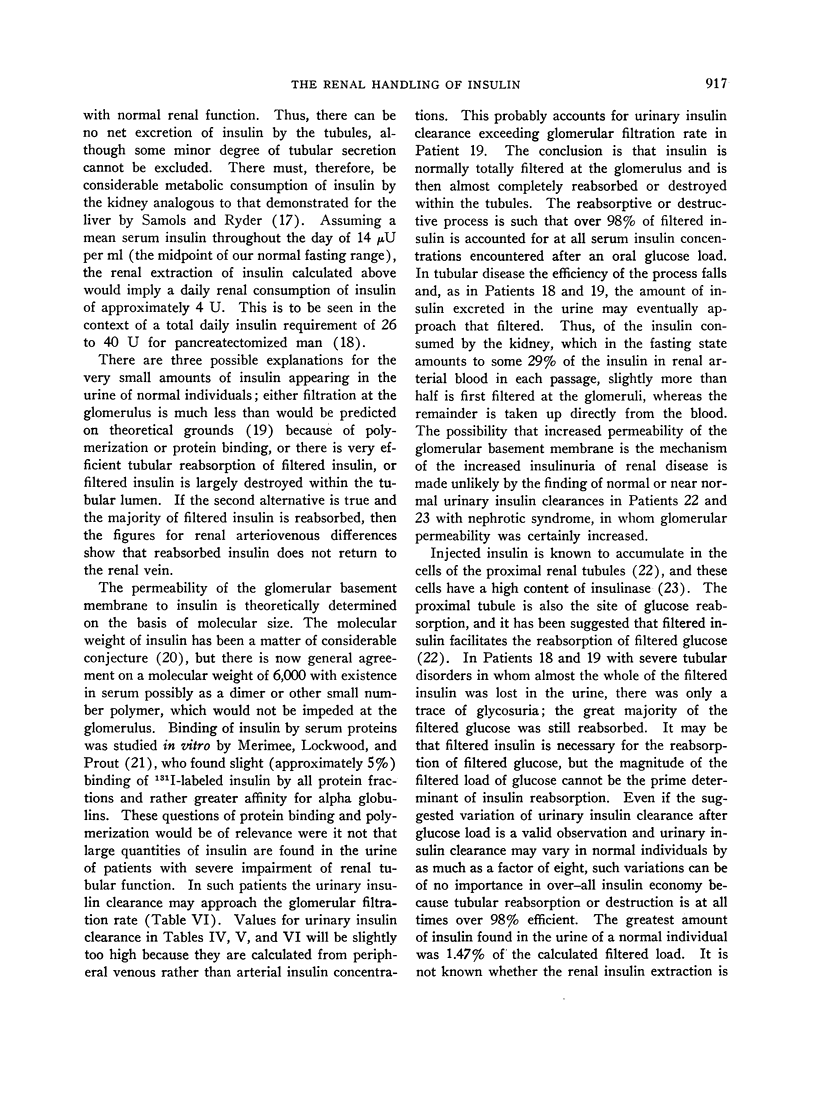Abstract
The renal handling of insulin was studied by insulin immunoassay in arterial blood, renal venous blood, and urine of fasting patients with normal renal function and in peripheral venous blood and urine of normal subjects and patients with renal disease before and after an oral glucose load. A renal arteriovenous insulin concentration difference of approximately 29% was found and suggests that in normal subjects renal insulin clearance is significantly in excess of glomerular filtration rate. The insulin excreted in the urine of normal individuals at no time exceeded 1.5% of the load filtered at the glomerulus. This contrasts with the finding of a urinary insulin clearance approaching glomerular filtration rate in patients with severely impaired renal tubular function.
It is suggested that insulin is normally filtered at the glomerulus and then almost completely reabsorbed or destroyed in the proximal tubule. If reabsorption occurs, as seems more likely, reabsorbed insulin does not return to the renal vein and is presumably utilized in renal metabolism together with insulin taken up directly from the blood.
Caution is advised in the use of urinary insulin concentration or excretion as an index of serum insulin level or insulin secretion because a very small and variable proportion of filtered insulin appears in the urine in normal subjects, and major changes in urinary insulin excretion may arise as a result of minor tubular defects.
Full text
PDF








Selected References
These references are in PubMed. This may not be the complete list of references from this article.
- BLAINEY J. D., BREWER D. B., HARDWICKE J., SOOTHILL J. F. The nephrotic syndrome. Diagnosis by renal biopsy and biochemical and immunological analyses related to the response to steroid therapy. Q J Med. 1960 Apr;29:235–256. [PubMed] [Google Scholar]
- BUTLER E. A., FLYNN F. V., HARRIS H., ROBSON E. B. A study of urine proteins by two-dimensional electrophoresis with special reference to the proteinuria of renal tubular disorders. Clin Chim Acta. 1962 Jan;7:34–41. doi: 10.1016/0009-8981(62)90113-4. [DOI] [PubMed] [Google Scholar]
- DARMADY E. M. CORRELATION OF RENAL FUNCTION AND STRUCTURE. J Clin Pathol. 1965 Jul;18:493–499. [PubMed] [Google Scholar]
- EPSTEIN F. H., ZUPA V. J. Clinical correlates of the Kimmelstiel-Wilson lesion. N Engl J Med. 1956 May 10;254(19):896–900. doi: 10.1056/NEJM195605102541904. [DOI] [PubMed] [Google Scholar]
- Hampers C. L., Soeldner J. S., Doak P. B., Merrill J. P. Effect of chronic renal failure and hemodialysis on carbohydrate metabolism. J Clin Invest. 1966 Nov;45(11):1719–1731. doi: 10.1172/JCI105478. [DOI] [PMC free article] [PubMed] [Google Scholar]
- Jorgensen K. R. Immunoassay of insulin in human urine. Acta Endocrinol (Copenh) 1966 Mar;51(3):400–410. doi: 10.1530/acta.0.0510400. [DOI] [PubMed] [Google Scholar]
- KALANT N., CLAMEN M., HOFFMAN M. M. Effect of experimental nephrosis or alloxan diabetes in rats. Diabetes. 1958 Mar-Apr;7(2):140–146. doi: 10.2337/diab.7.2.140. [DOI] [PubMed] [Google Scholar]
- KAZANTZIS G., FLYNN F. V., SPOWAGE J. S., TROTT D. G. Renal tubular malfunction and pulmonary emphysema in cadmium pigment workers. Q J Med. 1963 Apr;32:165–192. [PubMed] [Google Scholar]
- MERIMEE T. J., LOCKWOOD D. H., PROUT T. E. THE RELATIONSHIP OF INSULIN I-131 TO SERUM PROTEIN FRACTIONS. Bull Johns Hopkins Hosp. 1965 Mar;116:191–203. [PubMed] [Google Scholar]
- MIDDLETON J. E., GRIFFITHS W. J. Rapid colorimetric micro-method for estimating glucose in blood and C. S. F. using glucose oxidase. Br Med J. 1957 Dec 28;2(5060):1525–1527. doi: 10.1136/bmj.2.5060.1525. [DOI] [PMC free article] [PubMed] [Google Scholar]
- McArthur R. G., Stimmler L. Urinary insulin excretion in healthy children and in siblings of childhood-onset diabetics. Lancet. 1966 Jun 4;1(7449):1236–1237. doi: 10.1016/s0140-6736(66)90241-8. [DOI] [PubMed] [Google Scholar]
- O'Brien J. P., Sharpe A. R., Jr Abnormal carbohydrate metabolism in renal failure. Metabolism. 1965 Dec;14(12):1294–1306. doi: 10.1016/s0026-0495(65)80011-7. [DOI] [PubMed] [Google Scholar]
- RABINOWITZ D., ZIERLER K. L. A METABOLIC REGULATING DEVICE BASED ON THE ACTIONS OF HUMAN GROWTH HORMONE AND OF INSULIN, SINGLY AND TOGETHER, ON THE HUMAN FOREARM. Nature. 1963 Aug 31;199:913–915. doi: 10.1038/199913a0. [DOI] [PubMed] [Google Scholar]
- RUNYAN J. W., Jr, HURWITZ D., ROBBINS S. L. Effect of Kimmelstiel-Wilson syndrome on insulin requirements in diabetes. N Engl J Med. 1955 Mar 10;252(10):388–391. doi: 10.1056/NEJM195503102521004. [DOI] [PubMed] [Google Scholar]
- SAMOLS E., RYDER J. A. Studies on tissue uptake of insulin in man using a differential immunoassay for endogenous and exogenous insulin. J Clin Invest. 1961 Nov;40:2092–2102. doi: 10.1172/JCI104435. [DOI] [PMC free article] [PubMed] [Google Scholar]


